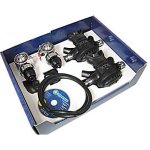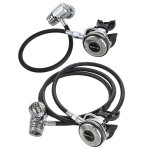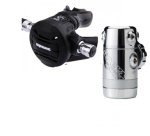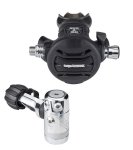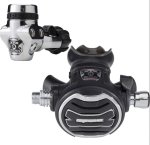Breathing is one of the most important things you do while underwater. You should not accept 'good enough' when making the important choice of which first and second stage regulators to use. That is why The Scuba Doctor has chosen to sell only high performance regulators for technical divers for the ultimate diving experience.
Tech Tip: Uncoupling DIN Fittings From SCUBA Valves
There is more to disconnecting a DIN fitting from a valve than you might imagine. Do it incorrectly and you will probably lose an O-ring and perhaps even need to have your regulator serviced. The problem is most pronounced in using DIN fittings on fill whips, and more rarely on first stage regulators. The O-ring popping out of the nose of the DIN fitting is an issue on scuba regulators and fill whip hoses and it is caused by failing to completely bleed residual pressure before uncoupling the fitting.
On fill whips, you can be certain all the pressure is released by opening the bleed and waiting a few extra seconds before starting to unscrew the fitting. You need to wait a moment after the hiss stops, because the bleed hole is tiny and gas will continue to escape even after the hissing stops. Compact ring-style bleeds found on fill whips that twist either direction to bleed are popular because you can't lose the bleed screw, but with this design you must make sure the ring is centred on the bleed opening because if you keep twisting you will close it again with out fully bleeding the hose.
Even when divers are using improper technique to unscrew DIN fittings on first stages, they rarely see the problem because usually they are unscrewing the fitting from a nearly empty cylinder with relatively little pressure remaining. But if the cylinder is nearly full and the diver encounters a circumstance where the first stage DIN fitting must be unscrewed then proper technique can very important. Briefly purging the second stage just once is not enough, residual pressure trapped in the high-pressure hose of the SPG will take several seconds to move all the way back through the regulator first stage to the second stage. You must wait a moment between each time you push the purge and you must do it three times in a row to fully release all the pressure from the hoses. Another equally effective two-handed technique is to continue to hold the second stage purge down in one hand while you begin to unscrew the DIN fitting using the other hand.
DIN fitting designs on regulators use a two or three part assembly in which the threaded component with a hand-wheel collar slides onto a hollow centre post and is retained by a 'nose cap' that contains the sealing DIN O-ring on the front and a smaller O-ring on the back. Improperly unscrewing the collared threads by rocking the entire assembly back and forth, or just using brute force to 'break' the seal can eventually can loosen the centre post and/or nose cap causing a leak or seal failure the next time you try to use the fitting. Sometimes you can 'save-a-dive' by using a hex wrench to hand tighten the DIN assembly, but a loose assembly is nearly impossible to permanently correct in the field and usually requires bench service to be able to fully tighten and lock the assembly back in place.
Proper technique to uncouple a DIN fitting requires you be careful to only turn the collar in the DIN fitting — don't grab and turn the entire assembly. If you can't easily turn just the collar to unscrew, i.e. you have to use force on the the entire assembly to 'break' the seal, then the line is not fully depressurised and you need to repeat the bleed.


